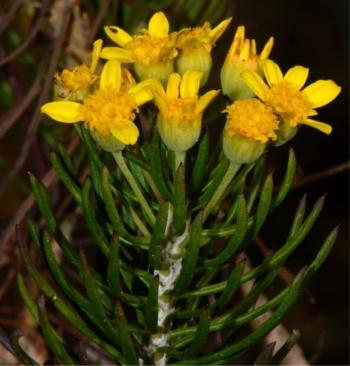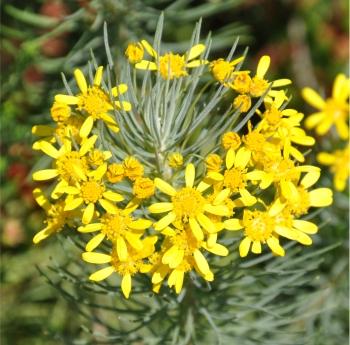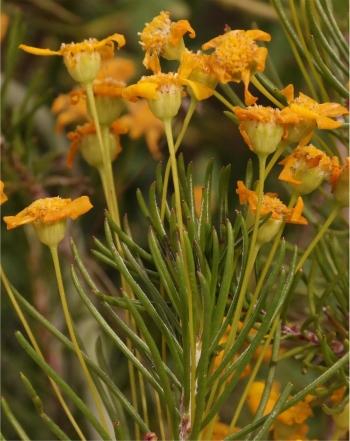Euryops linifolius
Euryops linifolius (L.) DC.
Family: Asteraceae
Common names: narrow-leaved resin bush (Eng.); smalblaarharpuisbos (Afr.)
Introduction
Euryops linifolius is a lovely evergreen shrub with grey-green, needle-like foliage and bright yellow flowers in spring. Occurring naturally in the drier parts of the Western Cape, this plant is ideally adapted to be water-wise.

Description
Description
Euryops linifolius is a fast-growing shrub, 0.6–2 m high, with grey-green foliage, which is immediately attractive to the eye, occurring sparsely at the base of and denser at the ends of the numerous branches. The densely clustered, needle-like leaves are about 50–100 mm long, with the ends most often divided into 3, long, thin lobes. Bright yellow or orange-yellow individual daisy flowers are borne on wiry stalks and occur in the upper parts and tips of the branches. These ‘flowers’, as with all the members of the daisy family, are actually flower-heads, composed of many tiny florets, clustered together on a dome-shaped inflorescence, from August to October, springtime in South Africa. The tiny seeds, which form soon after flowering, are hairless (a distinguishing feature) and become slimy when wet.

Often confused with E. tenuissimus, which can be distinguished by its hairy fruit, and E. thunbergii, which has a notable thin woolly line beneath each leaf.

Conservation Status
Status
Euryops linifolius is assessed as Least Concern (LC) according to the Red List of South African plants.
Distribution and habitat
Distribution description
Euryops linifolius is endemic to South Africa, where it occurs in the Western Cape, along the West Coast from Hopefield to Stellenbosch. It grows in well-drained soil, on sandy flats and rocky, sandstone slopes.

Derivation of name and historical aspects
History
Euryops is derived from the Greek eurys, meaning ‘large’ or ‘wide’, and ops, meaning ‘eye’ or ‘face’, referring to the large, showy flower heads or alternatively used in ecology to describe species with a wide range of tolerance for given environmental factors. The specific epithet linifolius is a description of the leaves, which are very narrow with parallel margins.
The common name harpuisbos, means 'resin bush' and is applied generally to most species of Euryops. It is a direct translation from the Dutch name harpuis bosch from the Dutch word hars, meaning ‘resin’ and puisje ‘small pustule’, referring to the resinous discharge that oozes from the stem and branches, in the form of small rounded drops, in many of the species.
The genus Euryops consists of 97 species, which occur through southern and tropical Africa, as well as in Saudi Arabia. There are 89 species in southern Africa, where they are widespread, with approximately 30 that occur within the Fynbos Biome.
Many Euryops are easy to grow, ornamental shrubs, well-suited for use in landscaping and the home garden. Good garden subjects that are grown at Kirstenbosch National Botanical Garden and are easy to find in the retail nurseries are, E. chrysanthemoides, E. linearis (De Hoop resin bush), E. pectinatus (woolly resin bush), E. virgineus (river resin bush) and E. chrysanthemoides x pectinatus ‘Kirstenbosch’, a lovely hybrid exhibiting the best characteristics of euryops. Two noteworthy species that are less easy to find in the trade but are well worth requesting are, E. tysonii and E. annae (small resin bush).
Ecology
Ecology
This plant is well adapted to summer drought, full sun conditions and wind. It has 3 major adaptations that make it waterwise: the grey colour of the foliage that reflects the heat and sunlight, the narrowness of the leaves, and the denseness of the foliage, reducing evaporation by providing self-shading and rebuffing of wind.
The masses of bright yellow daisy flowers attract pollinators such as bees, beetles and flies. When the seeds are wet and full of mucous, dispersal can be aided by larger mammals passing by and the seeds adhering to their coats until dry, when they drop off or are more easily brushed off as the animal passes through rocks, narrow spaces or scrub.
Uses
Use
Apart from very limited horticultural use, no other economic or cultural use is known for this species. The common name resin bush for plants of the genus Euryops comes from the use of the more resinous species by the early farmers as a source of gum.
Growing Euryops linifolius
Grow
Relatively fast growing, it doesn’t take long before it flowers, adding a splash of colour to your garden. It can be planted in any sunny spot in the garden and will grow in almost any light, well-drained soil. A water-wise plant in the winter-rainfall region, requiring only moderate watering.
If you have managed to find Euryops linifolius for purchase, they can be planted in groups in any sunny spot, or on terraces, or in a rockery. Add to spring annual plantings for a stunning colour display. Perfect for new gardens where the plants will thrive in the open conditions, similar to their natural habitat.
They are easy to care for. As a fast-growing shrub, they do not live all that long, with a life span of 2–4 years, which can be slightly extended with regular light pruning. Prune back lightly anytime but usually to best effect after the main flush of flowering, removing old flowers and nipping back growth tips to keep neat, to encourage new growth and a further batch of flowers. Compost lightly in autumn and spring.
Easily propagated from seed sown in autumn (March/April). If content in your garden they can seed themselves freely and young plants can often be found nearby. As soon as the seeds are ripe and well formed, they can be collected. Sow in seedling trays, using a well-drained seedling medium. Only lightly cover the seeds and keep them moist, but never too damp. Seeds should start germinating from about 4 to 6 weeks after sowing. Transplant the seedlings into bigger containers when they reach the 2-leaf stage. Sow fresh seed for best germination results.
Alternatively propagate in autumn from stem cuttings. Take cuttings in the early morning before the plants begin to actively transpire in the heat of the day, as this lessens the amount of stress the cuttings will be under and increases the chances of propagation success. Dip the cuttings in a hormone powder/solution to increase the rooting percentage and place in a suitable medium under moist (but not wet) conditions, until the roots form. A variety of rooting mediums can be used as long as they are well drained (sand, bark, palm fibre or vermiculite are all suitable). The cuttings root easily in approximately 4 weeks. Once the rooted cuttings have been hardened off, pot up the plantlets into any average, well drained potting soil. Once the young plants are well established, plant out into the garden.
References
- Joffe, P.1993. The gardener’s guide to South African plants. Tafelberg Publishers, Cape Town.
- Joffe, P. 2001. Creative gardening with indigenous plants. Briza Publications, Pretoria.
- Leistner, O.A. (ed.). 2000. Seed plants of southern Africa: families and genera. Strelitzia 10. National Botanical Institute, Pretoria.
- Manning, J. 2003. Photographic guide to the wildflowers of South Africa. Briza Publications, Pretoria.
- Manning, J. 2007. Field guide to Fynbos. Struik Publishers, Cape Town.
- Manning, J. 2009. Field guide to wild flowers of South Africa. Struik Nature, Cape Town.
- Pienaar, K. 1984. The South African what flower is that? Struik, Cape Town.
- Pienaar, K. 1985. Grow South African plants . Struik, Cape Town..
- Powrie, F. 1998. Grow South African plants. NBI Kirstenbosch, Cape Town.
- iNaturalist. Euryops linifolius observation by Nick Helme Accessed 28/09/18. https://www.inaturalist.org/observations/11067677
- iNaturalist. Euryops linifolius observation by Rolf Theodor Borlinghaus. Accessed 28/09/18. https://www.inaturalist.org/observations/11179865
- iNaturalist. Euryops thunbergii observation by Nick Helme Accessed 28/09/18. https://www.inaturalist.org/observations/11171992
Credits
Cherise Viljoen and Sanele Nkosi
Kirstenbosch National Botanical Garden
October 2018
Plant Attributes:
Plant Type: Shrub
SA Distribution: Western Cape
Soil type: Sandy, Loam
Flowering season: Spring
PH: Acid
Flower colour: Yellow
Aspect: Full Sun
Gardening skill: Easy
Special Features:
Horticultural zones








Rate this article
Article well written and informative
Rate this plant
Is this an interesting plant?
Login to add your Comment
Back to topNot registered yet? Click here to register.